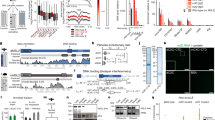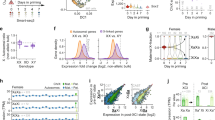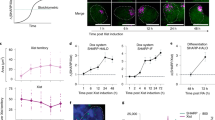Abstract
Gene expression in metazoans is regulated not only at the level of individual genes but also in a coordinated manner across large chromosomal domains (for example centromeres, telomeres and imprinted gene clusters1,2,3) and along entire chromosomes (for example X-chromosome dosage compensation4,5,6). The primary DNA sequence usually specifies the regulation of individual genes, but the nature of cis-acting information that controls genes over large regions has been elusive: higher-order DNA structure, specific histone modifications, subnuclear compartmentalization and primary DNA sequence are possibilities. One paradigm of chromosome-wide gene regulation is Caenorhabditis elegans dosage compensation in which a large dosage compensation complex (DCC) is targeted to both X chromosomes of hermaphrodites to repress transcript levels by half6. This essential process equalizes X-linked gene expression between the sexes (XO males and XX hermaphrodites). Here we report the discovery and dissection of cis-acting sites that mark nematode X chromosomes as targets for gene repression by the DCC. These rex (recruitment element on X) sites are widely dispersed along X and reside in promoters, exons and intergenic regions. rex sites share at least two distinct motifs that act in combination to recruit the DCC. Mutating these motifs severely reduces or abolishes DCC binding in vivo, demonstrating the importance of primary DNA sequence in chromosome-wide regulation. Unexpectedly, the motifs are not enriched on X, but altering motif numbers within rex sites demonstrates that motif co-occurrence in unusually high densities is essential for optimal DCC recruitment. Thus, X-specific repression is established through sequences not specific to X. The distribution of common motifs provides the foundation for repression along an entire chromosome.
This is a preview of subscription content, access via your institution
Access options
Subscribe to this journal
Receive 51 print issues and online access
$199.00 per year
only $3.90 per issue
Buy this article
- Purchase on Springer Link
- Instant access to full article PDF
Prices may be subject to local taxes which are calculated during checkout


Similar content being viewed by others
References
Grewal, S. I. S. & Elgin, S. C. R. Heterochromatin: new possibilities for the inheritance of structure. Curr. Opin. Genet. Dev. 12, 178–187 (2002)
Yamada, T., Fischle, W., Sugiyama, T., Allis, C. D. & Grewal, S. I. S. The nucleation of heterochromatin by a histone deacetylase in fission yeast. Mol. Cell 20, 173–185 (2005)
Reik, W. et al. Chromosome loops, insulators, and histone methylation: new insights into regulation of imprinting in clusters. Cold Spring Harb. Symp. Quant. Biol. 69, 29–37 (2004)
Nusinow, D. A. & Panning, B. Recognition and modification of sex chromosomes. Curr. Opin. Genet. Dev. 15, 91–122 (2005)
Lucchesi, J. C., Kelly, W. G. & Panning, B. Chromatin remodeling in dosage compensation. Annu. Rev. Genet. 39, 615–651 (2005)
Meyer, B. J. X-chromosome dosage compensation. 〈http://www.wormbook.org/chapters/www_dosagecomp/dosagecomp.html〉 (2005)
Chuang, P.-T., Albertson, D. G. & Meyer, B. J. DPY-27: a chromosome condensation protein homolog that regulates C. elegans dosage compensation through association with the X chromosome. Cell 79, 459–474 (1994)
Lieb, J. D., Albrecht, M. R., Chuang, P.-T. & Meyer, B. J. MIX-1: An essential component of the C. elegans mitotic machinery executes X chromosome dosage compensation. Cell 92, 265–277 (1998)
Losada, A. & Hirano, T. Dynamic molecular linkers of the genome: the first decade of the SMC proteins. Genes Dev. 19, 1269–1287 (2005)
Bhalla, N., Biggins, S. & Murray, A. W. Mutation of YCS4, a budding yeast condensin subunit, affects mitotic and nonmitotic chromosome behavior. Mol. Biol. Cell 13, 632–645 (2002)
Dej, K. J., Ahn, C. & Orr-Weaver, T. L. Mutations in the Drosophila condensin subunit dCAP-G: defining the role of condensin for chromosome condensation in mitosis and gene expression in interphase. Genetics 168, 895–906 (2004)
Cobbe, N., Savvidou, E. & Heck, M. M. Diverse mitotic and interphase functions of condensins in Drosophila. Genetics 172, 991–1008 (2006)
Csankovszki, G., McDonel, P. & Meyer, B. J. Recruitment and spreading of the C. elegans dosage compensation complex along X chromosomes. Science 303, 1182–1185 (2004)
Dawes, H. E. et al. Dosage compensation proteins targeted to X chromosomes by a determinant of hermaphrodite fate. Science 284, 1800–1804 (1999)
Bailey, T. L. & Elkan, C. in Proceedings of the Second International Conference on Intelligent Systems for Molecular Biology (eds Altman, R., Brutlag, D., Karp, P., Lathrop, R. & Searls, D.) 28–36 (AAAI Press, Menlo Park, California, 1994)
Miller, L. M., Plenefisch, J. D., Casson, L. P. & Meyer, B. J. xol-1: a gene that controls the male modes of both sex determination and X chromosome dosage compensation in C. elegans. Cell 55, 167–183 (1988)
Dahlsveen, I. K., Gilfillan, G. D., Shelest, V. I., Lamm, R. & Becker, P. B. Targeting determinants of dosage compensation in Drosophila. PLoS Genet. 2, e5 (2006)
Gilfillan, G. D. et al. Chromosome-wide gene-specific targeting of the Drosophila dosage compensation complex. Genes Dev. 20, 858–870 (2006)
Alekseyenko, A. A., Larschan, E., Lai, W. R., Park, P. J. & Kuroda, M. I. High-resolution ChIP-chip analysis reveals that the Drosophila MSL complex selectively identifies active genes on the male X chromosome. Genes Dev. 20, 848–857 (2006)
Legube, G., McWeeney, S. K., Lercher, M. J. & Akhtar, A. X-chromosome-wide profiling of MSL-1 distribution and dosage compensation in Drosophila. Genes Dev. 20, 871–883 (2006)
Hertz, G. Z. & Stormo, G. D. Identifying DNA and protein patterns with statistically significant alignments of multiple sequences. Bioinformatics 15, 563–577 (1999)
Acknowledgements
We thank A. Coulson for cosmids; S. Uzawa for technical innovation with image analysis; P. Nix for help with xol-1 XO rescue experiments; M. Ralston for statistical analysis; and R. Auty, M. Botchan, S. Brenner, T. Cline, R. Losick, E. Ralston and A. Severson for comments on the manuscript. This work was supported by an NIH grant (B.J.M.), NIH training grants (P.M. and B.K.P.), and a Netherlands Organisation for Scientific Research (NWO) Talent fellowship (J.J.). B.J.M. is an investigator and J.J. an associate of the Howard Hughes Medical Institute.
Author information
Authors and Affiliations
Corresponding author
Ethics declarations
Competing interests
Reprints and permissions information is available at www.nature.com/reprints. The authors declare no competing financial interests.
Supplementary information
Supplementary Notes
This file contains Supplementary Methods, Supplementary Discussion and additional references (DOC 69 kb)
Supplementary Figure 1
This figure shows that rex arrays recapitulate DCC recruitment properties of X. DCC binding to rex-1 arrays requires the same dosage compensation proteins as binding to X chromosomes. Moreover, rex-1 sites integrated into autosomes recruit the DCC. Shown are confocal images of wild-type or dosage-compensation-defective intestinal cell nuclei carry either rex arrays or rex-1 sites integrated into autosomes. Cells were co-stained with DAPI, FISH probes, and antibodies to 3 different dosage compensation proteins. (PDF 2006 kb)
Supplementary Figure 2
This figure shows the distribution of modeled DCC recruitment sites in 30 kb segments tiled along X. The plot is juxtaposed on the recruitment map showing previously determined X regions of strong, weak, or undetectable DCC binding. (PDF 649 kb)
Supplementary Figure 3
This figure further illustrates that motifs A and B are critical for the recruitment of all DCC components to rex-1. Shown are confocal images of intestinal cell nuclei carrying either wild-type (rex-1•33) or mutant (rex-1•33mA1 or rex-1•33mB2) arrays that were co-stained with DAPI and antibodies against SDC-2 and SDC-3, the proteins critical for targeting all DCC proteins to X. (PDF 1997 kb)
Supplementary Figure 4
This figure illustrates that multiple A and B motifs collaborate to recruit the DCC. Shown are confocal images of intestinal cell nuclei carrying wild-type and mutant rex-1 – rex-4 arrays that were co-stained with DAPI, FISH probes to rex arrays, and antibodies to DPY-27. (PDF 8290 kb)
Supplementary Figure 5
This figure illustrates that rex-1 arrays compete with the X chromosome for DCC recruitment in young embryos. Shown are partial confocal projections of young embryos carrying rex-1 arrays stained with DAPI (blue), DPY-27 antibody (red), and a FISH probe (green) to identify the array. (PDF 5477 kb)
Supplementary Table 1
The table provides the DNA sequence and position (strand) of wild-type A and B motifs in rex sites and the mutant motifs used to analyze the role of motifs A and B. (DOC 60 kb)
Supplementary Table 2
Chi square analysis in this table shows significant correspondence between predictive model for DCC recruitment sites and previous DCC recruitment studies. (DOC 45 kb)
Rights and permissions
About this article
Cite this article
McDonel, P., Jans, J., Peterson, B. et al. Clustered DNA motifs mark X chromosomes for repression by a dosage compensation complex. Nature 444, 614–618 (2006). https://doi.org/10.1038/nature05338
Received:
Accepted:
Published:
Issue Date:
DOI: https://doi.org/10.1038/nature05338
This article is cited by
-
Non-canonical Drosophila X chromosome dosage compensation and repressive topologically associated domains
Epigenetics & Chromatin (2018)
-
Transcriptional modulation of entire chromosomes: dosage compensation
Journal of Genetics (2018)
-
Condensin, master organizer of the genome
Chromosome Research (2017)
-
Condensin-driven remodelling of X chromosome topology during dosage compensation
Nature (2015)
-
The maintenance of chromosome structure: positioning and functioning of SMC complexes
Nature Reviews Molecular Cell Biology (2014)
Comments
By submitting a comment you agree to abide by our Terms and Community Guidelines. If you find something abusive or that does not comply with our terms or guidelines please flag it as inappropriate.



